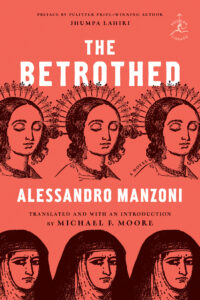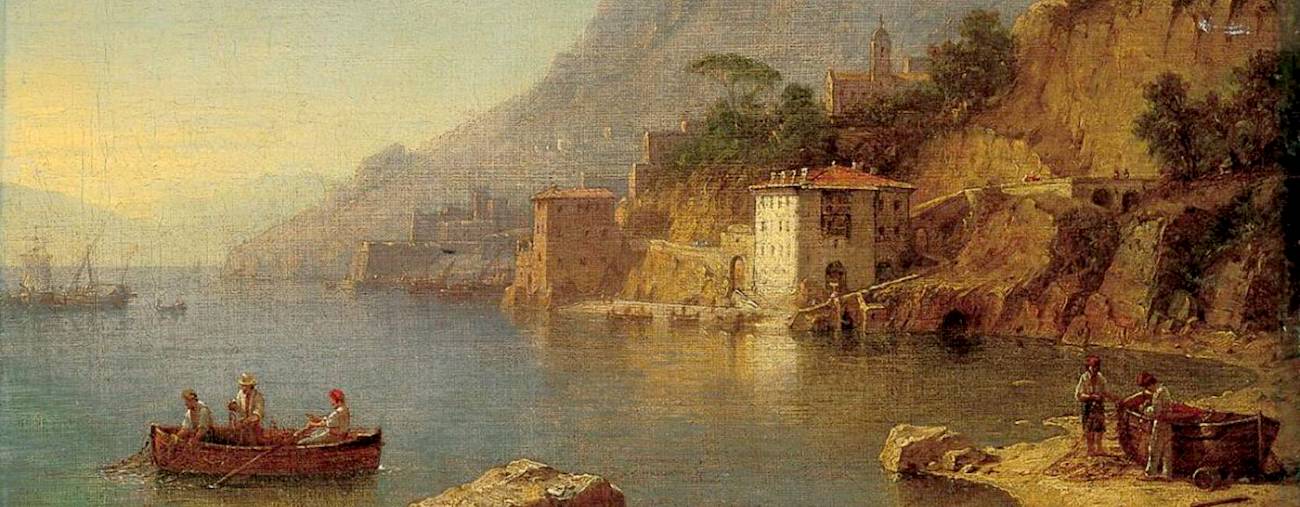I attended my first Italian wedding in the seaside town of Sestri Levante, on the Ligurian coast. The bride, who lived in Brooklyn in those days, as I did, was my Italian tutor. Her family hosted us warmly, and on the last day we spent together, before my own family and I were headed back to the airport in Genoa, they organized a final, intimate lunch with the newlyweds. In the affectionate confusion of saying goodbyes, the bride’s mother ran into a bookstore and placed a tome in my hands. It was a paperback copy of I promessi sposi.
Given that her daughter was teaching me Italian, she must have felt inspired to introduce me to Italy’s most celebrated novel—all 582 pages of it—in its original form. I was touched by her faith in me. Back then, I considered reading and understanding a short story in Italian a major accomplishment. That was in August of 2010. Ten years would pass before I opened the book, one cold January day in Princeton, New Jersey, and devoured it to the end in a burst of unabated enthusiasm.
Of course, I had tried to read it right away, as soon as I returned to Brooklyn after my tutor’s wedding. But even setting aside the staggering number of pages, Manzoni’s language was beyond me, and I knew that I was barely scratching the surface of what he was saying. To help things along, I procured a version of the book in English: The Betrothed. Unfortunately, I found the translation underwhelming and nearly as impenetrable. I read a few chapters before abandoning it.
When I moved to Italy, most of my friends groaned at the memory of having to slog through it in high school. None of the writers I befriended in Rome spoke about it much, perhaps because it was already a hallowed part of their collective consciousness. But my inability to reckon with Manzoni, in either English or in Italian, gnawed at me. And so I was thrilled when, in 2015, I learned that Michael Moore was at work on a new English version.
My inability to reckon with Manzoni, in either English or in Italian, gnawed at me.Michael (if I refer to him by first name, it is due to our friendship) had previously translated two of my most beloved authors—Alberto Moravia and Primo Levi—and reading his translations had motivated me to form intense relationships with both Moravia and Levi in Italian. He was the person I turned to (and still do) when I had questions about anything pertaining to contemporary Italian literature in translation. I was aware of his years of service on the translation committee of PEN, the many years he lived in Italy, and the perfect and completely natural Italian, which I longed to speak myself.
He had a polyhedric, erudite understanding of Italian history and the Italian language. He had written his doctoral dissertation on Petrarch but was also fluent in Italian popular culture, Italian as it is spoken on the streets, Italian slang. I found his work as an interpreter for the Permanent Mission of Italy to the United Nations utterly fascinating. If anyone could accomplish the herculean feat of transforming Manzoni’s masterpiece into an English that was as bracing and engaging as the original, it was he.
In 2016, when I taught my first translation workshop at Princeton University, I invited Michael to speak to my students about his experience of translating Manzoni. We compared the same chapter, one translated by Michael, the other by one of his predecessors. We spoke about how his translation-in-progress grabbed and shook us, banging its fist on the table as opposed to granting an affable nod.
Over the years, he returned twice more to visit my Princeton classes, to speak to different groups of students, always about Manzoni. Each time, the chapters he shared felt more supple, increasingly vital. My students were always delighted to listen to him impart all manner of practical and philosophical advice about the art and craft of translation. He inspired them, just as he has inspired me, to translate. He is an example of how love for another language and another culture can fulfill and revolutionize one’s life.
It has been both a privilege and a distinct pleasure to witness the lengthy, assiduous gestation of Michael’s translation of The Betrothed. Over the years he sent me emails from Zurich, Milan, and the shores of Lake Como (these last two locations serve, of course, as key settings for the novel) with updates on the state of the translation. We spoke of its methodical metamorphosis in person one summer in Rome, when he was working at a library in the Jewish Ghetto, and over the phone when he was in New York, juggling his formidable responsibilities as an interpreter.
I have followed the evolution of this translation from the early chapters he shared with my students to the ones that, at the time of this writing, are undergoing copyediting. I have watched him stand before two huge computer screens, translating literally on his feet, when he was Princeton’s Translator in Residence in the spring of 2018. Throughout this process, I was amazed by his endurance and his dedication to the task. I can no longer count the number of times I asked him, “Come va Manzoni? ” (How goes Manzoni?) and he replied, “Ci sono quasi” (I’m getting there). The fact that he has indeed gotten there, and that his masterful translation of The Betrothed is now in print, is a landmark literary occasion.
The study of Moore’s epic translation—arduous, intense, and also itinerant—mirrors the basic plot of the novel. Moreover, I regard Manzoni, who went through the backbreaking effort of rewriting his entire book in Tuscan dialect, even though it had already met with considerable popular and critical success upon its original publication in 1827, as a species of translator himself. In converting his work from one idiom to another, he was essentially self-translating. This feat took him thirteen years.
Manzoni fully deserves his place as Italy’s first and finest novelist, but he was also, in equal parts, a philologist who wrote essays on language, vocabulary, and the increasingly pressing question of what was to become unified Italy’s national tongue. Not surprisingly, speech and communication are among the novel’s principal themes. Manzoni’s sole purpose in reworking his text and unburdening it of regional inflections was to alter and update it linguistically, to make it more readable by rendering it less stuffy and stilted, more accessible and fresh. Michael Moore’s own unremitting objective, to modernize Manzoni, and thereby to render this classic work of Italian literature sprightly and contemporary, mirrors the drama that underlies the final apotheosis of the original novel.
The study of Moore’s epic translation—arduous, intense, and also itinerant—mirrors the basic plot of the novel.How has he done this? Here is not the place to pit one translation against another. That exercise, appropriate in the classroom, is illuminating for those who wish to analyze the infinitely debatable and mysterious inner workings of shifting from one language to another. I can vouch—having first fully appreciated Manzoni in Italian, then having turned to the present English translation—that the thrill has not been lost in translation; if anything, for the reader who loves both languages, it has only doubled.
Michael often used an Italian expression to describe the type of work he was doing: da certosino. This refers to the minute, patient work undertaken by the Carthusians, a hermetic order of monks founded by Bruno of Cologne in 1084 in the Valley of Chartreuse, near Grenoble, France. The Latin motto of the Carthusians, stat crux dum volvitur orbis, means “the cross is steady as the world turns.” Regardless of his physical whereabouts, this was Michael Moore’s state of mind as he combed through the thirty-eight chapters of Manzoni’s sprawling novel, meditating unwaveringly over every comma and each word. Only that level of concentration could have produced this translation, respectful but innovative, which Moore has inspected, considered, calibrated, buffed, and polished down to its last detail.
Take, for example, Manzoni’s habit of breathlessly stringing together a series of words and clauses that run pell-mell, without conjunctions, with either colons or semicolons between them—an irrepressible asyndeton that is typical of his high-octane prose. Here is an example in chapter 13, at the mention of the name Ferrer: “Surprise, joy, rage, sympathy, or revulsion bursts out everywhere reached by that name. Some shout it, some want to stifle it, some proclaim it, some reject it, some bless it, some curse it.”
This is the original: Una maraviglia, una gioia, una rabbia, un’inclinazione, una ripugnanza, scoppiano per tutto dove arriva quel nome; chi lo grida, chi vuol soffogarlo; chi afferma, chi nega, chi benedice, chi bestemmia.” Even if you don’t read Italian, you can admire the way Moore preserves the cadence, how dexterously he unfurls the words, how he maintains the anaphora that chops steadily through the sentence. Nothing clouds or compromises Manzoni’s streamlined syntax. Here is another example of the author’s lyrical listing: “In un batter d’occhio, cavalieri, fornai, avventori, pani, banco, panche, madie, casse, sacchi, frulloni crusca, farina, pasta, tutto sottosopra.” And in Moore’s enterprising English: “In the blink of an eye everything was upside down: gentlemen, bakers, customers, bread loaves, counter, benches, bins, cupboards, sacks, threshers, wheat bran, flour, dough.”
This is the kind of dynamic prose that made me grab my pen and underline sentences as I was reading Manzoni in Italian. This happened as I read Michael’s translation as well. Our intrepid translator intuits and arrives at solutions for the sheer poetry of Manzoni’s prose—the onomatopoeia (this book happens to be full of sounds) and the alliteration. Thus the hard c’s in “aveva tentato il colpo maestro di condurlo caldo caldo alle carceri” become a concentration of m’s and t’s in “he attempted the master stroke of leading him straight to jail.”
When I read the whole of I promessi sposi in Italian, I marveled at Manzoni’s vocabulary. I had never encountered such lexical variety. I picked up adjectives like scellerato (wicked), smozzicato (shattered), stracco (exhausted), and fellonesco (treacherous). It excited me the way reading Shakespeare excites me, with its mix, to the modern ear, of the foreign and the strange. And though Manzoni labored to “unify” the Italian language, the novel comprises many different tongues: the Spanish of those who ruled much of the country, and the Latin of the church, the law, and the generally learned. There is even a citation, in translation, from Shakespeare’s Julius Caesar.
That Manzoni lived for years in France, and was an active participant in Parisian literary circles, certainly reinforces the multilingual nature of the novel. Another stylistic calling card of Manzoni is his penchant for similes, with human nature frequently likened to creatures in the animal world. They are everywhere in the novel, and each establishes connective tissue between this nineteenth-century work in prose and the medieval poetry of Dante before him, and Virgil and Homer before that. Here is one of my favorites from chapter 34: “Like a nest of snakes slowly uncoiling in the warmth of spring.
At every jolt, every bump in the road, the tragic heap shook and came apart grotesquely. Heads dangled, maidens’ braids unraveled, and arms slid out of the tangled mass of limbs to bang against the wheels, rendering an already horrifying sight even more heartbreaking and foul.” The tragic heap in question is actually a heap of corpses being carted away. The translation eloquently echoes Manzoni’s own heaping together of lyrical grandeur and the grotesque. Moore steers clear of making this complex imagery sound like an outmoded rhetorical flourish. Rather, he breathes life into it and allows it to command center stage.
In translating I promessi sposi and converting it into The Betrothed for a new millennium, Michael Moore has wrestled with a veritable literary obstacle course: a vast historical novel studded with characters, imbued with intrigue, structured by plots and subplots, and rife with technical information. It is one thing to revel in this amalgam of elements as a reader, quite another to translate it.
Moore has noted ties to Walter Scott in his introduction to this volume. I would include, among the many coordinates of this novel, such disparate works as Moby-Dick, War and Peace, The Odyssey, The Divine Comedy, and pretty much any work by Dickens. It was Michael Moore—whom we can now safely consider the critic par excellence in English of this novel, and who possesses an encyclopedic knowledge of its contents—who pointed out to me that every character in Manzoni speaks distinctly. It is thanks to his deep and sustained reading of the novel in the original that the English now boasts the same irony, the same playful repetitions, the same multiplicity of voices.
As I was drafting this preface, I had the opportunity to see a draft of his translation marked up with editorial suggestions. Michael’s comments in the tracked changes reveal not only his deep familiarity with this text, but his unquestionable authority. At one point he replies to a query: “I prefer to keep it this way. Renzo is very colloquial.”
A translation also celebrates a union between author and translator, between the two languages they represent, and this connection.I personally have been waiting with bated breath for Michael Moore to complete his translation, and for this book to be published. I look forward to Manzoni’s The Betrothed reaching and conquering new readers in the English language and to teaching Manzoni to my students again. The timing is ideal. More than ever, we need the grand, reassuring architecture of a novel from the 1800s—which in its own time shed light on the early 1600s—to give us perspective on some of the most tumultuous, troubling, and pressing matters that still pertain to our twenty-first century world: plague, those who deny scientific evidence of the plague, migration, refugee crises, hunger, foreign occupation, religious hypocrisy, tyranny, corruption, mob mentality, existential anguish, class warfare, incarceration, identity politics, privacy violations, the abduction and silencing of women, and the rights of two people who love each other to be married under the law. Manzoni’s novel—both emotionally gripping and coolly objective, both extremely spirited and deadly serious—will enthrall you and sober you in turns.
The subtitle to The Betrothed is “A Seventeenth-Century Milanese Story Discovered and Rewritten.” Much is layered into this seemingly discreet phrase: the narrative ruse of Manzoni literally uncovering a preexistent text in order to jump-start the narrative; the exuberant authorial intervention from start to finish; and last but not least, as previously mentioned, the deliberate reworking, or rewriting, of the language itself. Michael Moore has done no more and no less than to recover and rewrite Manzoni’s novel from start to finish, reckoning with it and relocating it in a language that, I hope, will enable new readers around the world—the many, many it deserves—to discover and fall in love with this text.
It was only after finishing I promessi sposi in 2020 that I understood the significance of receiving it at the end of a wedding ten years before. This story, like many of Shakespeare’s comedies, celebrates a union that must overcome a series of obstacles and adversities. It recounts the long runway that leads to the marriage of Renzo and Lucia, distinct individuals who vow to spend their lives together. A translation also celebrates a union between author and translator, between the two languages they represent, and this connection, which feels sacred for many translators, endures even after the work of the translation has finished.
The fruit of the union between an author and a translator is what enables literature to proliferate, perpetuate, and seduce readers around the world. I turn both to Manzoni and Michael Moore, in chapter 29, to describe the fruit of their fortuitous union: it is a strepitosa mutazione, an “amazing transformation.” Ripe at long last for the picking, it is now in our hands.
__________________________________

Excerpted from The Betrothed by Alessandro Manzoni, translated by Michael F. Moore. Copyright © 2022. Available from Modern Library, a division of Penguin Random House, LLC.


